Understanding the different types of marketplaces is essential for businesses looking to build new channels to sell your products and services. As mobile commerce continues to grow, selecting the right platform is critical for aligning with consumer trends and market demands. By making informed decisions based on these dynamics, businesses can expand effectively.
Types of Mobile Marketplace Apps
There are millions of marketplace apps out there. From the biggest ones like Amazon to small niche apps that sell customized jewelry or courses, mobile marketplace can be divided into the following categories:
Marketplace app types based on target audience
B2B marketplace apps
A B2B marketplace app targets business buyers who want to buy from other businesses. A B2B marketplace lists mostly wholesale suppliers and vendors who want to sell their services or products to other business owners, entrepreneurs, and resellers.

Alibaba is the most successful B2B platform that allows brands to connect with wholesalers in China. Buyers can quickly find the best manufacturers, discuss their requirements, and enjoy order protection while dealing with overseas suppliers.
B2C marketplace apps
A B2C marketplace connects businesses directly to end customers. A business lists a product or service on a marketplace app (that charges a commission on every successful sale) where buyers discover the product/service and buy directly.
B2C marketplace apps offer a huge variety to customers making them wildly popular all over the globe.
Amazon is currently the world’s biggest marketplace with millions of products listed by all kinds of businesses. There are B2C marketplaces other than ecommerce platforms, too.

Teachable is a great example of a B2C marketplace that sells digital products. Teachable allows teachers, coaches, and gurus to create, promote, and sell their information products like eBooks, courses, etc.
P2P marketplace apps
A peer-to-peer (P2P) marketplace app connects two individuals who want to enter a contract of exchange. For example, a listing platform that allows one user to upload a listing for his old car and another user to connect with the seller directly to buy the car.
P2P networks and marketplace apps allow a user to become a seller or a buyer at different times according to the need.
Airbnb, Etsy, Uber, Quikr, and OLX are all types of P2P marketplaces where people list their products, services, or properties for others to buy or rent.

Upwork is a great example of a successful P2P platform where buyers (businesses) and sellers (freelancers) find each other, complete projects, and pay securely.

Marketplace app types based on focus
General or horizontal marketplace apps
A horizontal marketplace app offers products across multiple product or service categories. Think of it as an online shopping mall where you can buy different products under a single roof. A horizontal marketplace app has the following characteristics:
- Large group of customers coming from different socio-economic groups and having diverse needs
- Wide range of products across multiple categories and industries
- Sellers come from different industries and segments to promote their business on the same platform
- Cross-selling, upselling, and personalized recommendations can help increase the average order value
Amazon, Flipkart, and eBay are examples of a horizontal marketplace. Customers with different needs browse these platforms to find products that meet their needs.
Niche marketplace apps or vertical marketplaces
Niche marketplaces are more evolved in terms of users. These marketplaces offer specialized goods or services only in a specific segment or industry.
Vertical marketplaces work really well in the B2B space by simplifying procurement and operations.
Marble is a B2B vertical marketplace in the grocery space that digitizes grocery procurement for retail stores. Chemnet is a vertical marketplace for businesses in the chemical industry.
With evolving needs of modern consumers, vertical marketplaces have also conquered the B2C segment.
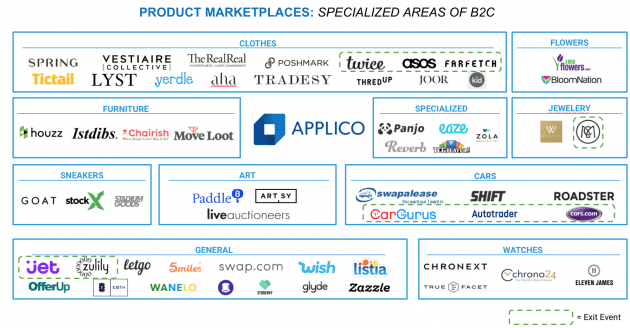
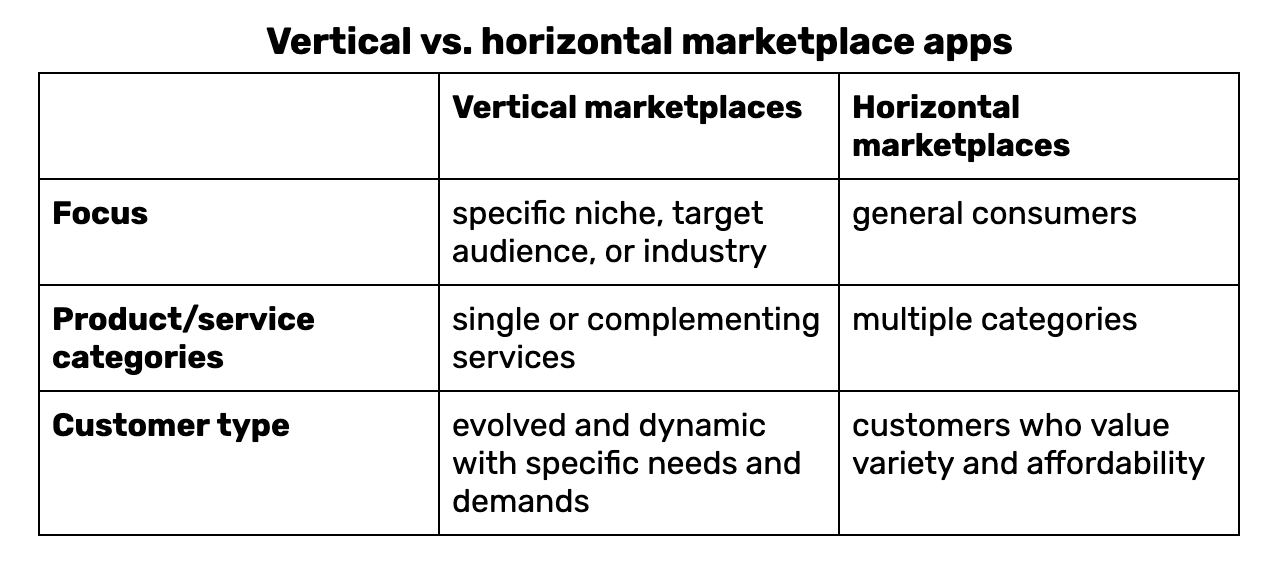
Marketplace apps based on supervision
Unmanaged marketplaces
Unmanaged marketplaces are mostly P2P marketplaces where buyers and sellers discover each other.
The marketplace owner often doesn’t provide quality assurance or background checks. Buyers are expected to do due diligence on their own.
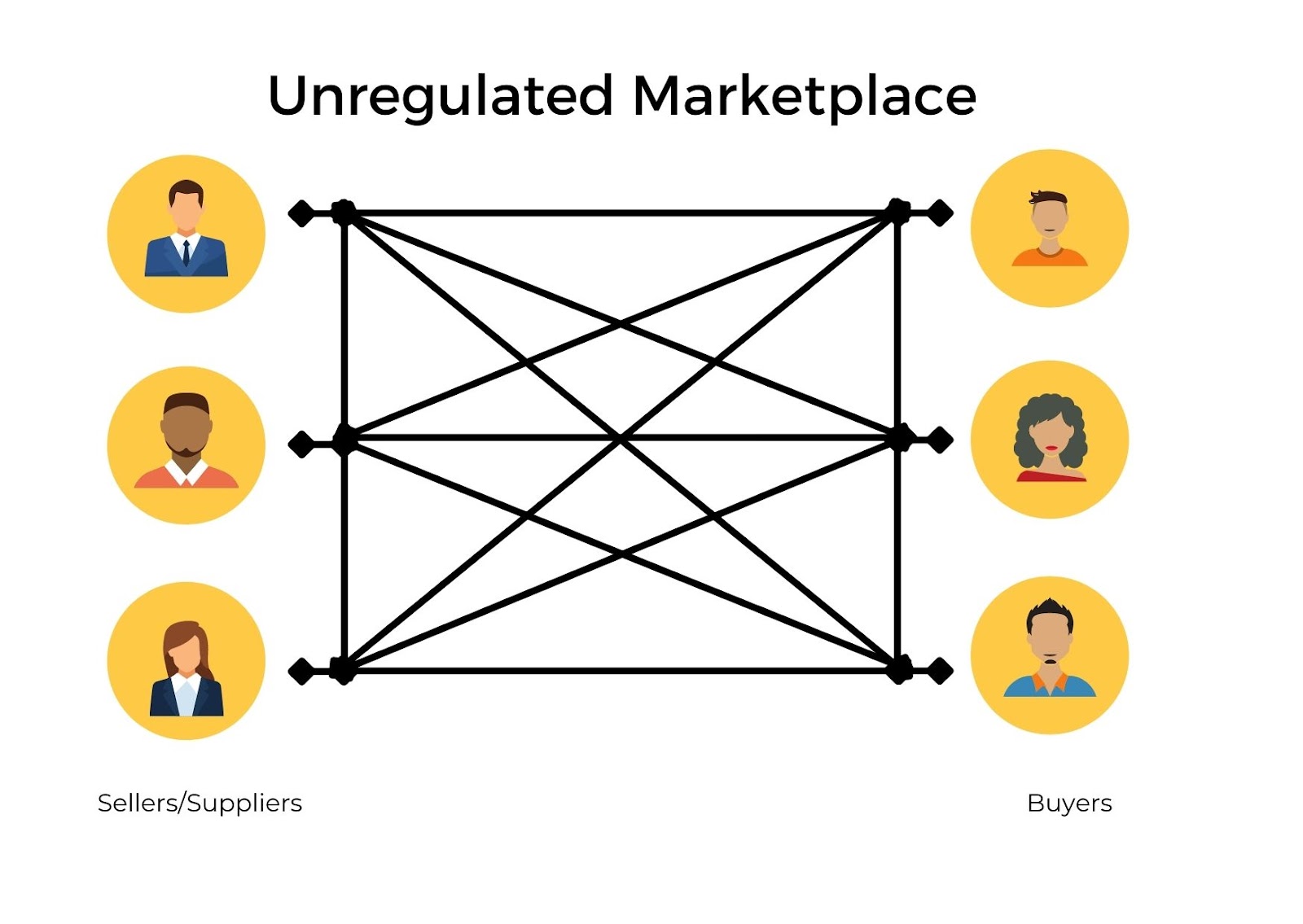
Reviews and ratings affect purchase decisions on such platforms. These marketplaces usually charge very little commission or work or freemium model.
Classified listing portals like OLX, Quikr, and eBay are the best examples of unmanaged marketplaces. Anyone can upload their listing to get discovered by the buyer and move ahead with a sale.
Partially managed marketplaces
Service delivery startups or aggregator platforms like Uber, Zomato, GrubHub can be considered as a partially-managed marketplace.
These marketplaces invest time, money, and effort in developing an onboarding process for sellers.

Marketplace-guided onboarding assures buyers that purchases are supervised to some degree. For example, when you book a ride via Uber, you expect the driver to be well-behaved and trained. Or when you book a stay via Booking, you don’t have to worry about the cleanliness of the room.
These marketplaces give buyers the best of both worlds — a large variety of independent choices, plus customer support to address any complaints or suggestions.
Fully managed marketplaces
A fully managed marketplace assists both buyers and sellers throughout the entire sales process. Such marketplaces operate in specialty industries where quality matters most.
A managed marketplace acts as an intermediary in a transaction, conducts background checks, and ensures minimal chances of fraud.

Notch, previously known as ChefHero, is a fully-managed marketplace for the restaurant industry. Notch acts as an aggregator for restaurant owners that assures them of high-quality restaurant supplies by onboarding select vendors and distributors in Canada and the USA.
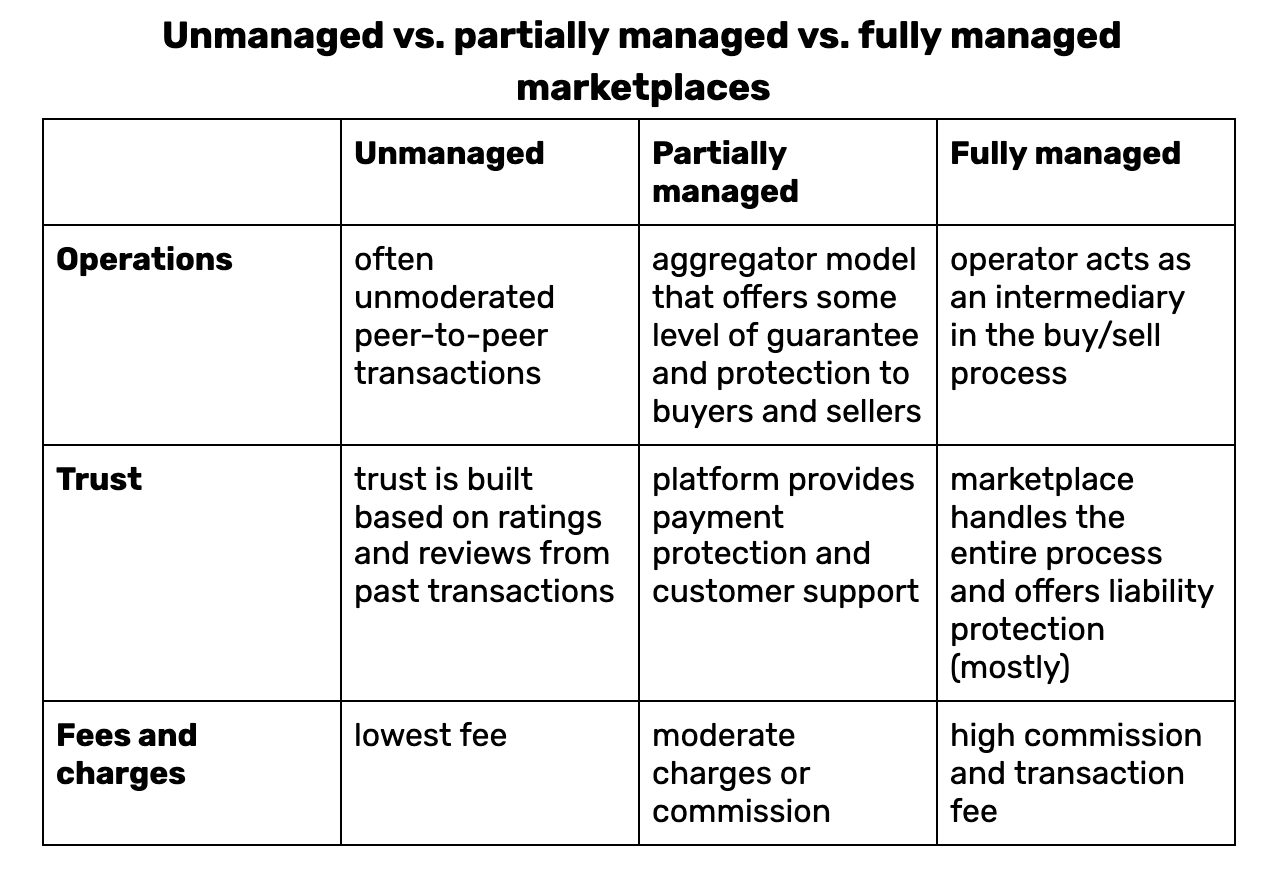
Marketplace App Business Models: How They Earn Money?
Marketplace apps bridge the gap between buyers and sellers and cater to both sides of the supply chain.
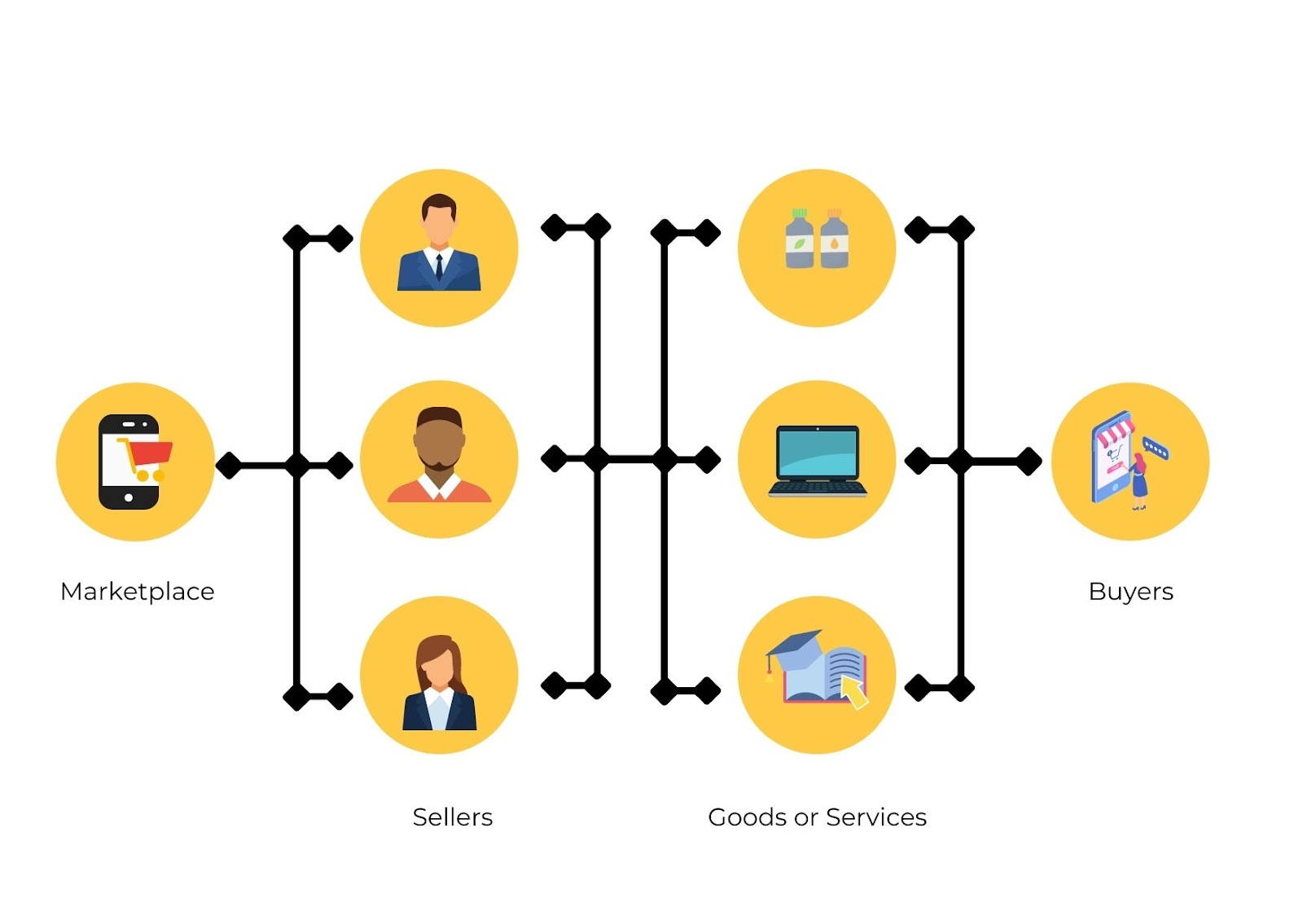
Buyers browse a marketplace app and order their desired products or services. Generally, the marketplace charges some type of commission or fee for every successful transaction. But there are other ways to earn money as a marketplace, too.
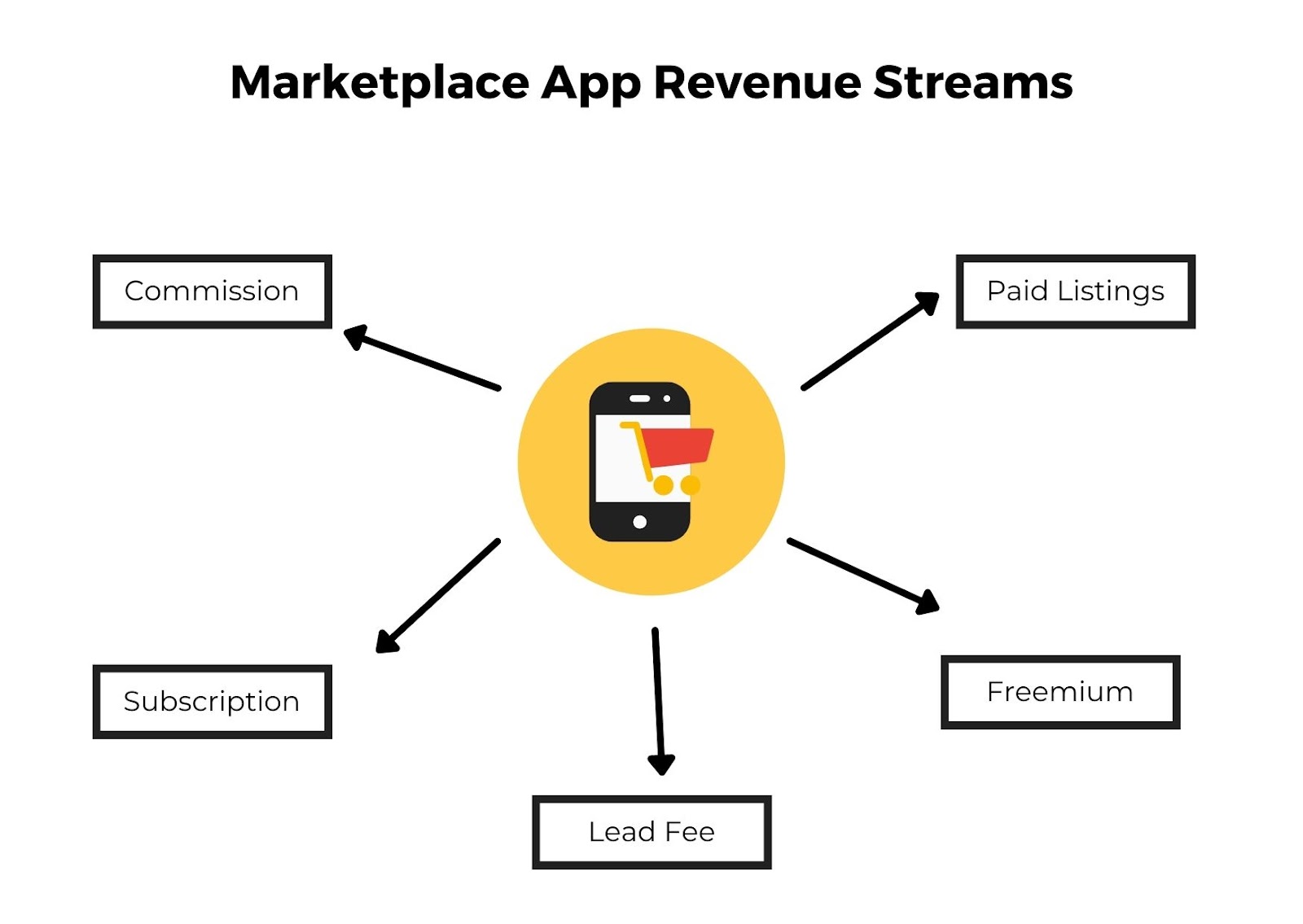
Commission model
The most common way for a marketplace to earn money is to charge commissions. Marketplace apps get fixed or variable commission on every successful order. Generally, sellers pay percentage-based commissions on sales. But some marketplace apps charge commissions from buyers, too.
Amazon, Airbnb, eBay, AppSumo, and Gumroad are marketplaces working on a commission model.
Commission-based marketplaces are free to join for sellers. They pay a commission only when a successful transaction happens. This model is quite viable for sellers who want to enter a third-party marketplace app for better reach and higher sales potential.
A commission-based marketplace app offers ancillary services such as payment processing, order management, and payment protection.

Subscription model
A subscription-based marketplace charges a monthly or annual membership fee from users. Users pay upfront and are charged on a recurring basis for accessing the platform features.
Such platforms have to deliver a continuous value to customers to encourage the renewal of memberships.
Dating apps, learning platforms, or real-estate marketplaces offer subscription packages to end-users. Other companies, institutions, and service providers upload courses, services, or products that are available for users for a fixed monthly fee.

HomeExchange is a subscription-based marketplace that allows its members to swap homes for holidays (or otherwise) for a fixed fee of $150 per year.
Other examples include dating platforms such as OkCupid and Match.com or professional platforms such as LinkedIn Recruiter.

Freemium model
In a freemium marketplace, users have the option to either subscribe to a paid plan for additional features or use the app for free. Both sellers and buyers can use the marketplace app without payment, but the free plan limits the functionality and features.
Monetization in a freemium marketplace happens through upselling and cross-selling of complementary services or products, or by offering subscription plans.
Craigslist is the best example of a marketplace working on the freemium model. Posting a classified ad on Craigslist is free, but if you want to list a house or real estate, you have to pay.
Freepik is another popular marketplace that works on the freemium model. Anyone can download select photos for free, but if a user wants access to a complete library, they need to subscribe to a monthly or annual subscription plan.

Listing model
Marketplace apps that charge money for listing products or services on their platform fall under this category. eBay, Etsy, and Realtor and several other P2P marketplaces work on similar models.
A seller pays a listing fee to the marketplace app owner upfront to get visibility for its offerings. Such platforms don’t facilitate the buying and selling of the listed product. Instead, they prefer charging an upfront fee from the seller to launch the listing.
Listing model ensures that the marketplace never misses on the monetization of less popular items within its app. Generally, such a model is prevalent in real estate, automobile, and similar industries where high-ticket sales happen

Lead fee model
These marketplaces charge money from service providers in return for a qualified lead that’s ready to buy. You probably have used such marketplaces if you’re in the professional services industry.
Freelance marketplaces like Upwork work on a similar business model. Users post their requirements on the platform and professionals pay money to the marketplace for placing a bid on a listing. They’re also charged a small commission if a customer hires them for completing a job.

Hybrid model
As the marketplace ecosystem evolves, apps have started monetizing their platforms with a mix of revenue streams. A hybrid marketplace model depends on multiple revenue streams such as commissions, listing fees, success fees, membership fees, and more all at the same time.
Etsy is the perfect example of a marketplace evolving into a hybrid business model, where sellers can either list for free, subscribe to a paid plan, and even get charged commissions on every successful sale.
Getting Started with Mobile Marketplace Development
Marketplace apps offer businesses an opportunity to tap into the large ecommerce market share. And while marketplace apps can be lucrative undertakings, the key is to build them with consumers involved in the decision-making. Only after listening to consumer shopping habits will you be able to draw conclusions that will let you create unique value in the industry.
FAQ for Mcommerce
How many types of marketplace are there?
There are primarily four types of marketplaces: B2C (Business-to-Consumer), where businesses sell to individual consumers; B2B (Business-to-Business), where transactions occur between businesses; C2C (Consumer-to-Consumer), enabling consumers to sell to each other; and M2M (Machine-to-Machine), which involves exchanges primarily in the realm of IoT and services.
What is the most common marketplace?
The most common type of marketplace is B2C (Business-to-Consumer). In this model, businesses provide goods and services directly to individual consumers, typically through mobile apps or mobile websites. This model encompasses a wide range of industries including retail, services, and digital products.
What does it mobile commerce?
Mobile commerce refers to any transaction with a monetary value that is conducted through a mobile device. This can include a variety of activities such as purchasing products through a mobile app or mobile websites, conducting mobile banking operations, and utilizing mobile payments solutions like Apple Pay. It represents a shift in how consumers access online shopping platforms, emphasizing convenience and immediacy.
What are the advantages of mobile commerce?
The advantages of mobile commerce are manifold. They include the convenience of shopping and conducting financial transactions anywhere and anytime using a mobile device. It offers businesses the opportunity to reach a wider audience, as more consumers use their mobile devices for shopping and payments. Personalization is another significant advantage; mobile apps can tailor recommendations and deals to individual user preferences. Finally, it supports faster transactions and instant access to products and services, enhancing the overall customer experience and potentially increasing sales.
What is the market size of mobile commerce?
The market size of mobile commerce has seen substantial growth in recent years, driven by increased smartphone adoption and consumer preference for shopping on mobile devices — in 2024, mcommerce sales will reach $558.29 billion. As mobile shopping and mobile payments become more integrated into daily life, businesses are expanding their mobile apps and mobile websites to cater to this trend. While specific numbers fluctuate, the trend indicates a significant expansion in market size and scope, reflecting the shifting habits of consumers worldwide towards mobile-based commerce.
How can AR and VR be used in mobile commerce?
In mobile commerce, AR (augmented reality) and VR (virtual reality) technologies can significantly enhance the shopping experience. They allow customers to visualize products in their own environment before purchasing, through AR, or immerse themselves in a completely virtual shopping environment with VR. These technologies can help in trying out items such as clothes, furniture, or makeup virtually, providing a more engaging and informative shopping experience. They can also be used for interactive marketing campaigns and in-store navigation, further bridging the gap between online and physical shopping environments.

Related articles
Supporting companies in becoming category leaders. We deliver full-cycle solutions for businesses of all sizes.


.png)

